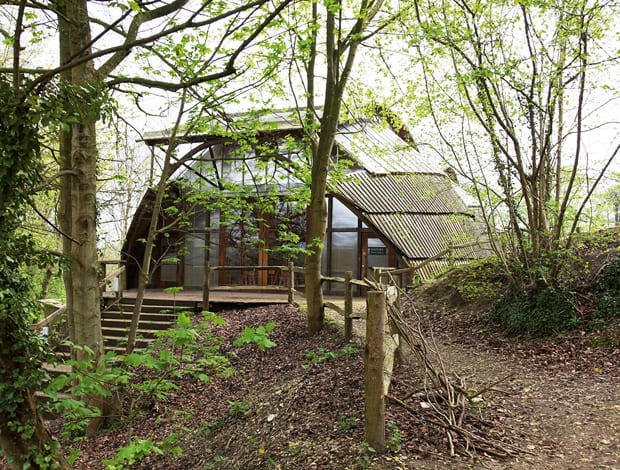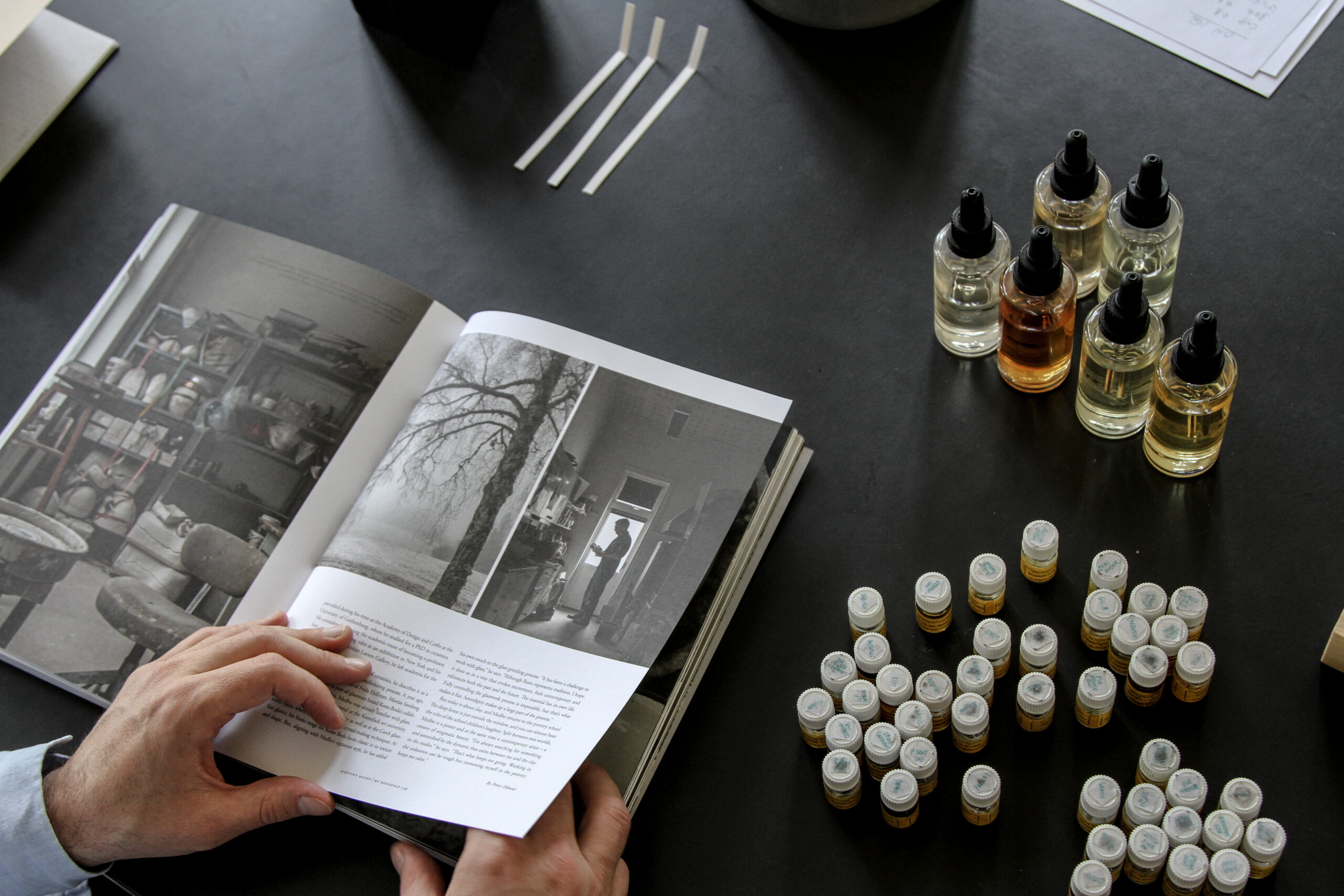 The Downland Gridshell seems to have grown from its surroundings|The curved oak lattice of the Downland Gridshell at the Weald & Downland Museum in Susse|The ancient art of wattle and daub|The man himself, Edward “Ted” Cullinan|Cullinan’s RMC HQ in Surrey features the largest rooftop garden in the country|Workspaces in the herbarium and library wing at Kew Gardens|The wooden and glass exterior of the herbarium and library at Kew|Block D Masshouse in Birmingham: part of Cullinan’s masterplan for Masshouse Circus|Overhead view and graphic of the Masshouse masterplan|External shot of the International Digital Laboratory at the University of Warwick||
The Downland Gridshell seems to have grown from its surroundings|The curved oak lattice of the Downland Gridshell at the Weald & Downland Museum in Susse|The ancient art of wattle and daub|The man himself, Edward “Ted” Cullinan|Cullinan’s RMC HQ in Surrey features the largest rooftop garden in the country|Workspaces in the herbarium and library wing at Kew Gardens|The wooden and glass exterior of the herbarium and library at Kew|Block D Masshouse in Birmingham: part of Cullinan’s masterplan for Masshouse Circus|Overhead view and graphic of the Masshouse masterplan|External shot of the International Digital Laboratory at the University of Warwick||
Veteran British architect Edward Cullinan talks new modernism, egalitarianism, and why he loves wood
“Architecture is the celebration of necessity. That is, you discover what is needed and then you add a bit more that’s needed, and then you express those needful things,” says Edward Cullinan, founder of London-based practice Edward Cullinan Architects.
He has been expressing these needful things for nearly 50 years now, placing him firmly in the elder statesman camp, but the passion and intelligence that has seen the practice scoop numerous awards and Cullinan himself the RIBA Royal Gold Medal is there in spades. Of course, longevity doesn’t necessarily lead to variety, but in Cullinan’s case one cannot fail to be impressed by the broad spectrum of projects.
The naturalism of the wooden armadillo-like shell of the Downland Gridshell in Sussex and the striking modernism of Cambridge University’s Centre for Mathematical Sciences illustrate just how versatile Cullinan can be. This fluency in styles has ensured his practice will always have a capacity to surprise and excite.
It is currently working hard on a Maggie’s Centre at the Freeman Hospital in Newcastle, which incorporates a rooftop garden underneath a curved photovoltaic roof. Using a black felt pen, Cullinan sketches out the project with fluid speed, a casual demonstration of his skill as a draughtsman.
“Our work is very situational,” explains the architect, casually dressed in jeans and a shirt with the sleeves rolled up. “We have tended to have jobs in very tricky historical places as well as in ordinary places. We don’t like mimicking past styles but we do design in a way that, I won’t say fits in, I would say complements the existing situation. And that has made it vary quite a bit.”
Interesting geography notwithstanding, Cullinan’s steadfast commitment to sustainable design, something he professes to still be learning about, has also undoubtedly played a strong hand.
“There are great possibilities for offices if the users are prepared to use their heads and imaginations”
The practice has a well-deserved reputation for paying particular attention to carbon emissions, and for Culllinan this can be seen in what he calls a “new modernism”. A pitch perfect example of this is the Downland Gridshell at the Weald and Downham museum. Made from an oak lattice enveloped in cedar sourced from a nearby forest, the Stirling Prize-nominated building remains one of Cullinan’s best loved projects.
“We could have covered that green oak roof with elephant skin, with a plastic sheet. But we wanted to go to the next stage to cover the parts overlapping each other, deliberately enjoying the aesthetic possibilities of low-energy materials,” he says. “And that’s why I like it – I don’t like it for moral reasons. I like it purely for aesthetic reasons.” If Cullinan is playing the curmudgeon it’s an awkward fit, and a quick double take confirms tongue is lodged firmly in cheek.
Wood is a material that Cullinan loves to work with. Appreciative of its “astonishingly rich expressive possibilities”, it’s no surprise to see timber play a substantial role in his new herbarium and library for Kew Gardens. Due to officially open later this year, the building features timber and glass research offices that undulate around a three-storey, brick-clad archive, which is attached to the existing herbarium by a drum structure made from more timber and glass.
The practice is most notable for its cultural and educational schemes, but on the odd occasion that it delves into the commercial sphere, the results are entertaining.
The Ready Mix Concrete (now Cemex) headquarters in a Cheltenham garden are an excellent yardstick. Boasting the largest rooftop garden in the country, the single-storey offices are ventilated by huge chess pieces on their roofs, all the while melting into their lush surroundings. “There are great possibilities for offices if the users are prepared to use their heads and imaginations,” says Cullinan. But although he can envisage the potential, he is less than impressed with reality.
“Many office buildings are made as cheaply as possible on flat sites in boring places,” he says. Meanwhile, the practice is seeking to extend its premises on the Regent’s Canal in north London. Planning has been granted, but the recession has put things on hold for the time being.
“We don’t like mimicking past styles but we do design in a way that, I won’t say fits in, I would say complements the existing situation”
Early this year Edward Cullinan Architects scooped an industry award for best architectural practice, with the judges highlighting Cullinan’s HR policies. He is somewhat non-plussed by this, however.
“What’s an HR policy?” he asks. “I think the fact that I don’t know what the hell HR means is a good indication of how I feel about it.”
Corporate acronyms may be a mystery (and reassuringly so), but it’s clear Cullinan cares deeply about his people.
For a start everyone calls him Ted, but it runs deeper than mere familiarities. The practice has been running as a co-operative since the late 1960s. Modelled on the giant Spanish co-operative Mondragon Corporation, it means that Cullinan earns no more than three times that of the newest member. A spotlight has been shone on architects’ wages lately, revealing a picture that is far from rosy, so it’s heartening to see such a difference here. The fact that nearly a fifth of the practice’s 37 members has remained in the company for over 20 years speaks volumes.
“Of course, it means I am not as rich as I might otherwise have been,” says Cullinan. “But I am not as poor as I otherwise would have been had I failed.”
On occasion, the co-operative goes a little further than just work. Cullinan owns a farm on the north Staffordshire moors and is currently planting an elliptical ring of trees. For four weekends every winter, the workforce is invited to take part in the planting sessions.
“They come out there, consume the produce of north Staffordshire and have a lot to eat and drink,” he says.
The image conjured is one worthy of Thomas Hardy, and Cullinan assures me there is never a shortage of volunteers. With the practice’s egalitarian tendencies, it is tempting (though foolhardy) to picture an ego-free utopia with little time for prima donnas. Cullinan balks at this suggestion.
“Oh, we most certainly do have them. Why did little Johnny say to his mummy, ‘I want to be an architect’ if he wasn’t a bit of a prima donna?” And with that, balance is returned to the universe.
























